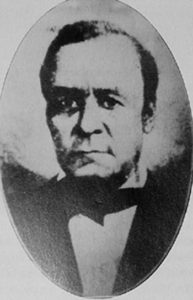
William Goodridge
*The birth of William Goodridge is celebrated on this date in 1805. He was a Black businessman and abolitionist.
He was born in Maryland to an African mother and an unknown white father. Little is known about his early years other than that he and his mother were slaves. His master unexpectedly freed him when he was 16. Goodridge is said to have left York, Pennsylvania, around 1822, and he learned the barber trade, possibly in Marietta, Pennsylvania. He returned to York between 1823 and 1825 and opened a barbershop on Centre Square, known today as Continental Square.
The barbershop grew into a grand, sky-lighted photography studio and emporium. Historically, many free Blacks became barbers. It is also known that their clientele was very diverse, and sought-after barbers like Goodridge were able to interact with prominent white citizens. Goodridge's interaction with influential white businessmen allowed him to form relationships that informed his business decisions.
Due to his successful business transactions, by 1845, Goodridge had become a wealthy and talented businessman in York. Apart from being a retailer of various commodities, Goodridge owned about twenty commercial and residential properties. In 1847, he built a five-story building known as Centre Hall and was also credited with introducing the sale of daily newspapers in York. Eventually, he entered the railroad business with the Goodridge Reliance Line of Burthen Cars, offering services between York, Philadelphia, and more than 20 other cities.
Goodridge used his wealth to provide aid to the Underground Railroad. His railroad operation often moved enslaved Blacks on the way to freedom. His network made him a key “conductor” and “station master.” He befriended Frederick Douglass, John Brown, Frances Harper, Stephen Smith, and other abolitionist change agents. On the third floor of the Goodridge building in Center Square, Goodridge concealed Osborn Perry Anderson following his participation with John Brown in the 1859 insurrection at Harper’s Ferry. Anderson fled to Canada and was the only participant in that ill-fated event to survive, thanks partly to Goodridge and Pennsylvania’s Underground Railroad members. After the American Civil War, he remained a prosperous York businessman, and his impact on the community continued.
Soon, Goodridge moved from York to Minneapolis to live with his daughter, Emily, and her husband, Ralph Grey. The family had been in Minnesota since the late 1850s and was active in the anti-slavery movement in Minnesota. They were instrumental in helping emancipate a woman named Eliza Winston in 1860. The Grey's second son, Toussaint L'Ouverture Grey, named after the liberator of Haiti, was born in 1859, the first Black child born in St. Anthony. Toussaint died from heart disease on June 28, 1868, at nine.
William Goodridge died on January 15, 1873, from congestive heart failure. He was buried in the southwest corner of Minneapolis Pioneers and Soldiers Memorial Cemetery next to his son, Glenalvin Goodridge, and his grandson, Toussaint Grey. Despite the prominent role that William Goodridge played in the Underground Railroad, his accomplishments have not been widely known in Minnesota. Once family members left the state, the location of his grave was forgotten. Friends of the Cemetery rediscovered it in June 2003.